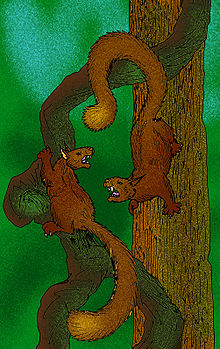| This article relies largely or entirely on a single source. Relevant discussion may be found on the talk page. Please help improve this article by introducing citations to additional sources. Find sources: "Kopidodon" – news · newspapers · books · scholar · JSTOR (April 2020) |
| Kopidodon Temporal range: Early Eocene | |
|---|---|

| |
| Kopidodon macrognathus | |
| Scientific classification | |
| Domain: | Eukaryota |
| Kingdom: | Animalia |
| Phylum: | Chordata |
| Class: | Mammalia |
| Mirorder: | Ferae |
| Order: | †Pantolesta |
| Family: | †Paroxyclaenidae |
| Subfamily: | †Paroxyclaeninae |
| Genus: | †Kopidodon |
| Species: | †K. macrognathus |
| Binomial name | |
| †Kopidodon macrognathus (Wittich, 1902) | |
Kopidodon is a genus of extinct squirrel-like mammals belonging to the order Cimolesta. Kopidodon was one of the largest tree-dwelling mammals known from Eocene Europe: growing 115 centimeters long (most of that length is tail). This mammal sported large canine teeth, probably for defense, since its molars were adapted for chewing plants, not flesh. Its legs and claws allowed Kopidodon to scramble through the trees with the greatest of ease, much like modern-day squirrels. Its fossils were found in the Messel pit, preserving even its fur. Kopidodon had a thick bushy tail for balance.

References
- William A. Clemens and Wighart von Koenigswald: A new skeleton of Kopidodon macrognathus from the Middle Eocene of Messel and the relationship of paroxyclaenids and pantolestids based on postcranial evidence. Kaupia 3, 1993, S. 57–73
| Taxon identifiers | |
|---|---|
| Kopidodon | |
This prehistoric mammal-related article is a stub. You can help Misplaced Pages by expanding it. |


